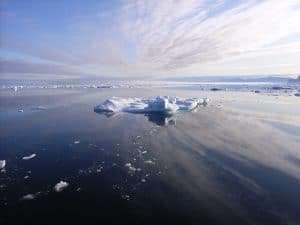
A new international study finds that the Atlantic meridional overturning circulation, a deep-ocean process that plays a key role in regulating Earth’s climate, is primarily driven by cooling waters west of Europe.
In a departure from the prevailing scientific view, the study shows that most of the overturning and variability is occurring not in the Labrador Sea off Canada, as past modelling studies have suggested, but in regions between Greenland and Scotland. There, warm, salty, shallow waters carried northward from the tropics by currents and wind, sink and convert into colder, fresher, deep waters moving southward through the Irminger and Iceland basins.
Overturning variability in this eastern section of the ocean was seven times greater than in the Labrador Sea, and it accounted for 88 percent of the total variance documented across the entire North Atlantic over the 21-month study period.
University of Oxford researchers Helen Johnson (Earth Sciences) and David Marshall (Physics) participated in the study, led by Duke University in the United States and the National Oceanography Centre in the UK.
“The overturning circulation has a major impact on how the Atlantic sector responds to climate change” said Marshall. “Recent work at Oxford has shown that the high latitude North Atlantic is the most important region for understanding how the overturning responds to anthropogenic climate change”.
“Changes in the rate of overturning affect the transfer of heat to high latitudes and can impact on Arctic sea ice” added Johnson.
“These findings, unexpected as they may be, can help scientists better predict what changes might occur to the meridional overturning circulation and what the climate impacts of those changes will be”, said project lead Susan Lozier (Duke University, United States).
“As scientists, it is exciting to learn that there are more pieces to the overturning puzzle than we first thought,” said coauthor Johannes Karstensen (GEOMAR Helmholtz Centre for Ocean Research, Germany).
The paper, published on 1 February in Science, is the first from the £25 million, five-year initial phase of the OSNAP (Overturning in the Subpolar North Atlantic Program) research project, in which scientists have deployed moored instruments and sub-surface floats across the North Atlantic to measure the ocean’s overturning circulation and shed light on the factors that cause it to vary.
Primary funding came from the US National Science Foundation’s Physical Oceanography Program and the UK Natural Environment Research Council. Additional funding came from the European Union 7th Framework Programme and Horizon 2020.
CITATION: A Sea Change in Our View of Overturning – First Results from the Overturning in the Subpolar North Atlantic Program, M.S. Lozier, F. Li, S. Bacon, F. Bahr, A.S. Bower, S.A. Cunningham, M.F. de Jong, L. de Steur, B. DeYoung, J. Fischer, S.F. Gary, N.J.W. Greenan, N.P. Holliday, A. Houk, L. Houpert, M.E. Inall, W.E. Johns, H.L. Johnson, C. Johnson, J. Karstensen, G. Koman, I.A. LeBras, X. Lin, N. Mackay, D.P. Marshall, H. Mercier, M. Oltmanns, R.S. Pickart, A.L. Ramsey, D. Rayner, F. Straneo, V. Thierry, D.J. Torres, R.G. Williams, C. Wilson, J. Yang, I. Yashayaev and J. Zhao. Science, Feb. 1, 2019. DOI: 10.1126/science.aau6592.